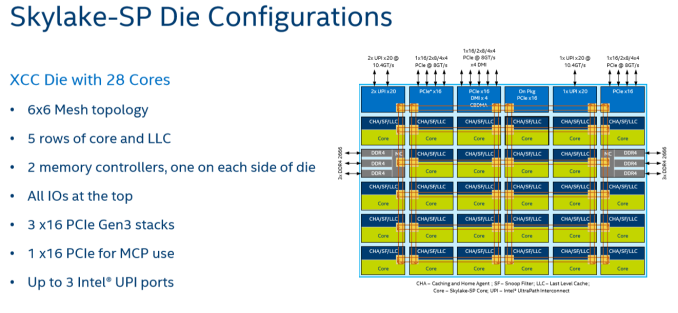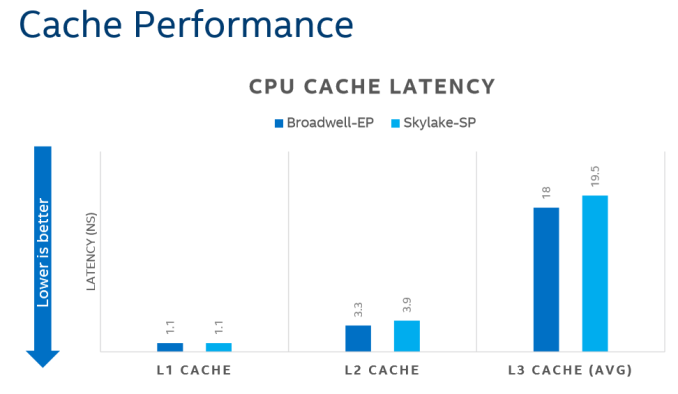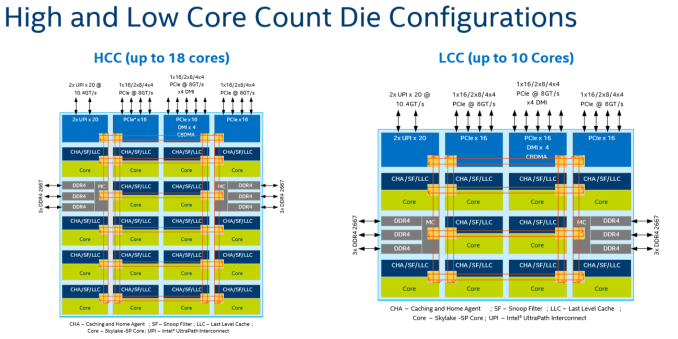Sizing Up Servers: Intel's Skylake-SP Xeon versus AMD's EPYC 7000 - The Server CPU Battle of the Decade?
by Johan De Gelas & Ian Cutress on July 11, 2017 12:15 PM EST- Posted in
- CPUs
- AMD
- Intel
- Xeon
- Enterprise
- Skylake
- Zen
- Naples
- Skylake-SP
- EPYC
Intel's New On-Chip Topology: A Mesh
Since the introduction of the "Nehalem" CPU architecture – and the Xeon 5500 that started almost a decade-long reign for Intel in the datacenter – Intel's engineers have relied upon a low latency, high bandwidth ring to connect their cores with their caches, memory controllers, and I/O controllers.
Intel's most recent adjustment to their ring topology came with the Ivy Bridge-EP (Xeon E5 2600 v2) family of CPUs. The top models were the first with three columns of cores connected by a dual ring bus, which utilized both outer and inner rings. The rings moved data in opposite directions (clockwise/counter-clockwise) in order to minimize latency by allowing data to take the shortest path to the destination. As data is brought onto the ring infrastructure, it must be scheduled so that it does not collide with previous data.
The ring topology had a lot of advantages. It ran very fast, up to 3 GHz. As result, the L3-cache latency was pretty low: if the core is lucky enough to find the data in its own cache slice, only one extra cycle is needed (on top of the normal L1-L2-L3 latency). Getting a cacheline of another slice can cost up to 12 cycles, with an average cost of 6 cycles.
However the ring model started show its limits on the high core count versions of the Xeon E5 v3, which had no less than four columns of cores and LLC slices, making scheduling very complicated: Intel had to segregate the dual ring buses and integrate buffered switches. Keeping cache coherency performant also became more and more complex: some applications gained quite a bit of performance by choosing the right snoop filter mode (or alternatively, lost a lot of performance if they didn't pick the right mode). For example, our OpenFOAM benchmark performance improved by almost 20% by choosing "Home Snoop" mode, while many easy to scale, compute-intensive applications preferred "Cluster On Die" snooping mode.
In other words, placing 22 (E7:24) cores, several PCIe controllers, and several memory controllers was close to the limit what a dual ring could support. In order to support an even larger number of cores than the Xeon v4 family, Intel would have to add a third ring, and ultimately connecting 3 rings with 6 columns of cores each would be overly complex.
Given that, it shouldn't come as a surprise that Intel's engineers decided to use a different topology for Skylake-SP to connect up to 28 cores with the "uncore." Intel's new solution? A mesh architecture.
Under Intel's new topology, each node – a caching/home agent, a core, and a chunk of LLC – is interconnected via a mesh. Conceptually it is very similar to the mesh found on Xeon Phi, but not quite the same. In the long-run the mesh is far more scalable than Intel's previous ring topology, allowing Intel to connect many more nodes in the future.
How does it compare to the ring architecture? The Ring could run at up to 3 GHz, while the current mesh and L3-cache runs at at between 1.8GHZ and 2.4GHz. On top of that, the mesh inside the top Skylake-SP SKUs has to support more cores, which further increases the latency. Still, according to Intel the average latency to the L3-cache is only 10% higher, and the power usage is lower.
A core that access an L3-cache slice that is very close (like the ones vertically above each other) gets an additional latency of 1 cycle per hop. An access to a cache slice that is vertically 2 hops away needs 2 cycles, and one that is 2 hops away horizontally needs 3 cycles. A core from the bottom that needs to access a cache slice at the top needs only 4 cycles. Horizontally, you get a latency of 9 cycles at the most. So despite the fact that this Mesh connects 6 extra cores verse Broadwell-EP, it delivers an average latency in the same ballpark (even slightly better) as the former's dual ring architecture with 22 cores (6 cycles average).
Meanwhile the worst case scenario – getting data from the right top node to the bottom left node – should demand around 13 cycles. And before you get too concerned with that number, keep in mind that it compares very favorably with any off die communication that has to happen between different dies in (AMD's) Multi Chip Module (MCM), with the Skylake-SP's latency being around one-tenth of EPYC's. It is crystal clear that there will be some situations where Intel's server chip scales better than AMD's solution.
There are other advantages that help Intel's mesh scale: for example, caching and home agents are now distributed, with each core getting one. This reduces snoop traffic and reduces snoop latency. Also, the number of snoop modes is reduced: no longer do you need to choose between home snoop or early snoop. A "cluster-on-die" mode is still supported: it is now called sub-NUMA Cluster or SNC. With SNC you can divide the huge Intel server chips into two NUMA domains to lower the latency of the LLC (but potentially reduce the hitrate) and limit the snoop broadcasts to one SNC domain.














219 Comments
View All Comments
JohanAnandtech - Friday, July 21, 2017 - link
Thanks! It is was a challenge, and we will update this article later on, when better kernel support is available.serendip - Tuesday, July 11, 2017 - link
What idiot marketroid thought it was cool to have a huge list of SKUs and gimped "precious metals" branding? I'd like to see Epyc kicking Xeon butt simply because AMD has much more sensible product lists and there's not much gimping going on.ParanoidFactoid - Tuesday, July 11, 2017 - link
Reading through this, the takeaway seems thus. Epyc has latency concerns in communicating between CCX blocks, though this is true of all NUMA systems. If your application is latency sensitive, you either want a kernel that can dynamically migrate threads to keep them close to their memory channel - with an exposed API so applications can request migration. (Linux could easily do this, good luck convincing MS). OR, you take the hit. OR, you buy a monolithic die Intel solution for much more capital outlay. Further, the takeaway on Intel is, they have the better technology. But their market segmentation strategy is so confusing, and so limiting, it's near impossible to determine best cost/performance for your application. So you wind up spending more than expected anyway. AMD is much more open and clear about what they can and can't do. Intel expects to make their money by obfuscating as part of their marketing strategy. Finally, Intel can go 8 socket, so if you need that - say, high core low latency securities trading - they're the only game in town. Sun, Silicon Graphics, and IBM have all ceded that market.msroadkill612 - Wednesday, July 12, 2017 - link
"it's near impossible to determine best cost/performance for your application. So you wind up spending more than expected anyway. AMD is much more open and clear about what they can and can't do. Intel expects to make their money by obfuscating as part of their marketing strategy.Finally, Intel can go 8 socket, so if you need that - say, high core low latency securities trading - they're the only game in town. Sun, Silicon Graphics, and IBM have all ceded that market."
& given time is money, & intelwastes customers time, then intel is expensive.
Those guys will go intel anyway, but just sayin, there is already talk of a 48 core zen cpu, making 98 cores on a mere 2p mobo.
As i have posted b4, if wall street starts liking gpu compute for prompter answers, amdS monster apuS will be unanswerable.
nils_ - Wednesday, July 19, 2017 - link
98 cores on a 2p mobo isn't quite right if you keep in mind that the 32 core versions already constitute a 4 CPU system, unless AMD somehow manages to get more cores on a single die.nils_ - Wednesday, July 19, 2017 - link
Good analysis, although Sun and IBM are still coming out with new CPUs and at least with IBM there is renewed interest in the POWER ecosystem.eek2121 - Wednesday, July 12, 2017 - link
, but rather AMD's spanking new EPYC server CPU. Both CPUs are without a doubt very different: micro architecture, ISA extentions, <snip>Should be extensions.
intelemployee2012 - Wednesday, July 12, 2017 - link
After looking at the number of people who really do not fully understand the entire architecture and workloads and thinking that AMD Naples is superior because it has more cores, pci lanes etc is surprising.AMD made a 32 core server by gluing four 8core desktop dies whereas Intel has a single die balanced datacenter specific architecture which offers more perf if you make the entire Rack comparison. It's not the no of cores its the entire Rack which matters.
Intel cores are superior than AMD so a 28 core xeon is equal to ~40 cores if you compare again Ryzen core so this whole 28core vs 32core is a marketing trick. Everyone thinks Intel is expensive but if you go by performance per dollar Intel has a cheaper option at every price point to match Naples without compromising perf/dollar.
To be honest with so many Fabs, don't you think Intel is capable of gluing desktop dies to create a 32core,64core or evn 128core server (if it wants to) if thats the implementation style it needs to adopt like AMD?
The problem these days is layman looks at just numbers but that's not how you compare.
sharath.naik - Wednesday, July 12, 2017 - link
Agree, Most who look at these numbers will walk away thinking AMD is doing well with EPYC. The article points out the approach to testing and also states the performance challenges with EPYC, which can be missed who reading this review without the prior review on the older Xeons. For example the Big data test, I bet the newbies will walk away thinking EPYC beats the older XEONS E5 v4, as thats what the graphs show,without ever looking back at the numbers for a single 22 core Xeon e5 v4. So yes, a few back links in the article will be helpful.warreo - Wednesday, July 12, 2017 - link
Not a fanboi of either company, but care to elaborate more? I checked the original Xeon E5 v4 review. It shows that a single Xeon E5 v4 performs about 10% slower than a dual setup. Extrapolating that here, that means the single Xeon E5 v4 setup would be right around 4.5 jobs per day, which would make it roughly 50% slower than the dual Epyc and Xeon 8176.Sure, you could argue perf/dollar is better against a dual Epyc setup...but one could make the same argument against Intel's Skylake Xeons? I also wouldn't expect the performance to scale linearly anyway. Please let me know what I'm missing.